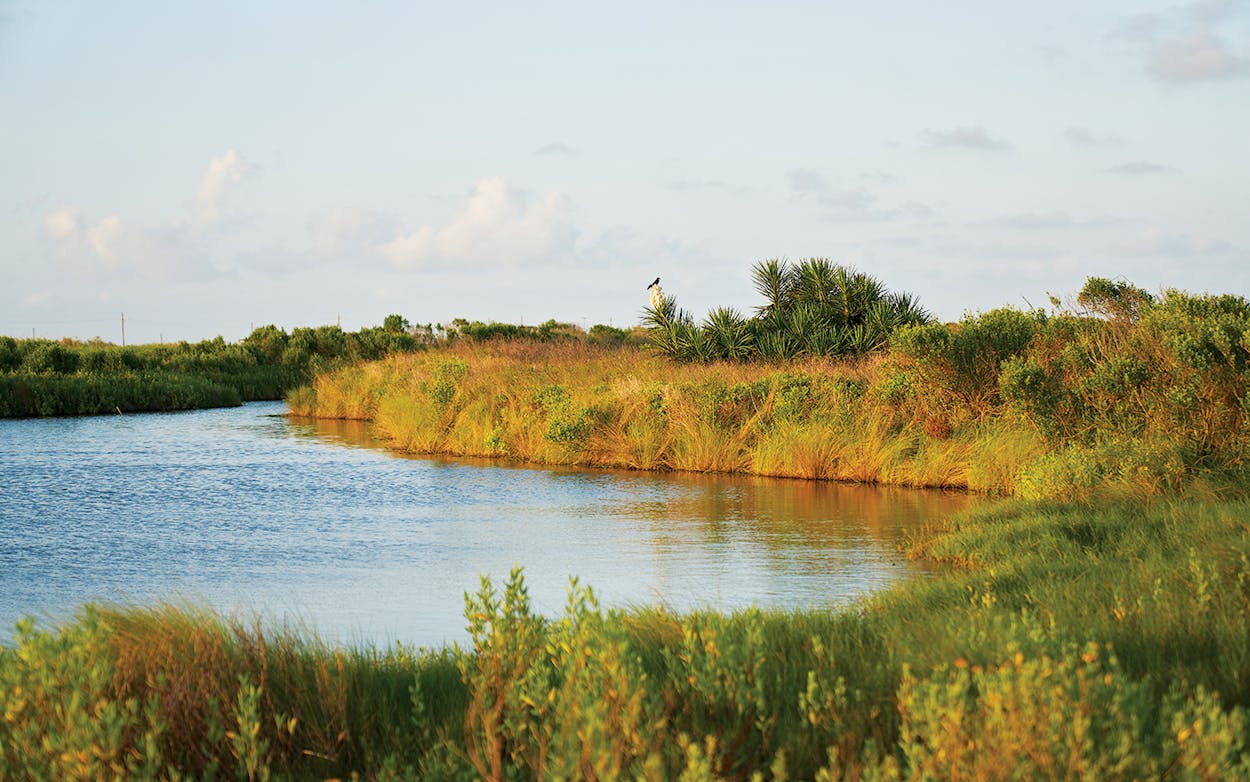Far away from the cares of urban life, discover a seaside refuge bursting with life,” says Texas Parks and Wildlife’s interpretive guide to Sea Rim State Park. “Bursting with life,” absolutely: the park is home to (or rest stop for) an awesome collection of critters, from neotropical birds and bobcats to coyotes and alligators. And they’ve got the “refuge” part down. The whole swath of coastal plain between the Louisiana state line and the Bolivar Peninsula is one giant patchwork of wildlife sanctuaries, not just Sea Rim but also the J. D. Murphree Wildlife Management Area as well as the Anahuac, McFaddin, and Texas Point national wildlife refuges. But I’m not sure about the “far away” part. That vast acreage of beach and marshland feels almost like a defiant bulwark against some very particular cares of urban life uncomfortably close at hand, namely one of the largest petrochemical complexes in the world squatting ominously between land and sea and everywhere wind-and-water-battered structures, relics of storms come and gone. The overall impression is one of a delicate habitat occupied by delicate creatures hanging on for dear life.
You can’t get to Sea Rim, a little over a hundred miles from Houston, without passing through a cluster of refineries, their intricate mazes of pipes looking like roller coasters and their smokestacks expelling what you could almost convince yourself are puffy white clouds. You used to be able to drive Texas Highway 87 from Bolivar’s High Island to Sabine Pass, but the state finally gave up on continually rebuilding that sixteen-mile stretch after a succession of storms capped off by 1989’s Chantal and Jerry. No doubt the park’s isolation is why few people I’ve spoken to have heard of it. As my trusty sidekick, Emily, and I discover when we visit, in mid-April, even some folks who live in its vicinity are unfamiliar with it.
Drive south from downtown Port Arthur, following Sabine Lake, and you’ll get to Sabine Pass, once a promising port city and now a hurricane-fatigued community that was annexed by Port Arthur in 1978. It’s also home to the only park-adjacent convenience store and gas station, which, when we stop by, is out of gas (fortunately we have enough). “Y’all have one job here!” I pretend to yell out the window, for Emily’s benefit, and we head ten miles west to Sea Rim, four thousand acres of marshland and five miles of beach whose rugged beauty inspires descriptions like “raw,” “unspoiled,” and “diamond in the rough.” Opened in 1977, the park has also seen its fair share of tempests. In 2005 Hurricane Rita caused so much damage the park had to close and rebuild; it was two weeks away from reopening, in 2008, when along came Ike. With Sea Rim’s history of weathering the vagaries of the weather, its facilities are understandably minimal: a visitors center housed in a trailer, a single cabin, fifteen RV sites, primitive beach camping, and, most intriguing, a 13-by-20-foot floating tent platform in the marsh that we briefly considered before factoring in the four miles of paddling (round-trip), the high possibility of clouds of mosquitoes, and the likelihood of voiding in a plastic receptacle within a rudimentary wooden shelter. Later we’ll meet an outdoorsy Houston family returning from a night on the platform who experienced all of the above, as well as a magical break from civilization, with a three-year-old in tow. “He pooped like a champ in that bucket,” Mom says.

Big fans of indoor plumbing, we have chosen the cabin, which is clean and comfortable and stark in that state-park-accommodations sort of way, decorated with historical photos of Sabine Pass and furnished with a chunky picnic table and bunk beds (single on top, full on bottom) equipped with waterproof mattress covers. “I’m not five years old!” Emily hollers indignantly while I unpack what seems like the entire contents of my home back in Austin. Sheets, towels, soap—just go ahead and bring everything. The cabin is furnished with a coffeepot, toaster, grill, can opener, toilet paper, and that’s about it. Pretty cushy for $95 a night. What it really has going for it is location, perched at the edge of what the park romantically calls its Marsh Unit (the Beach Unit being the other part, on the opposite side of 87). Boats, canoes, and kayaks launch from docks right outside the cabin onto a glassy pond of pea-green water that narrows into a channel that disappears enticingly into the marsh. We happily spend a good deal of time observing the wildlife from our screened-in porch—a preternaturally calm frog, chattering blackbirds fighting over prime bug-catching territory, silver-bellied mullet jumping one, two, three times across the water like skipping stones, and a resident alligator who casually comes and goes, its presence betrayed only by its head, the distance between the tip of its armored snout and two bulging eyes disconcertingly long.
On the subject of Sea Rim’s native alligators, the park’s literature provides abundant advice, much of which seems fairly obvious: “Absolutely do not feed or annoy the alligators.” “Do not throw objects in water for your dog to retrieve.” “If an alligator goes after a fish you have caught . . . let the alligator have the fish.” I’ve always known that the prehistoric-looking, seemingly sluggish creatures can outrun a human. I didn’t know that they could do so only up to about thirty feet; apparently, their tiny legs finally wear out. “Retreat uphill where possible.” My advice? Trip your buddy and run like hell.

Closed for Now
Sea Rim’s popular Gambusia Nature Trail boardwalk, which is named after the mosquito-larvae-eating fish and allows for up-close marsh exploration, has been shut down indefinitely for repairs.
Nah, don’t do that. Even if she accidentally locks both of you out of the cabin on your second night (one of those confounding push-and-twist locks that you can’t tell is locked on the outside until it’s too late). The sun has gone on its merry way, and so have the park staff. Calls to various locksmiths go mostly unanswered or politely declined. “I really don’t want to come out there,” says one potential rescuer. He suggests that we continue to call around or perhaps break a window. Then he finally takes pity on us and agrees to head our way. An hour and a half and $150 cash later, we are back in the sweet confines of our plywood walls. We send our hero off to resume his evening, and we settle in with a deck of playing cards and a bottle of red wine.
Sea Rim’s short strand of coastline is the main draw for most. Alas, we drive over there on a morning of frisky winds and leaden sky. We park and amble down a boardwalk through golden-green grasses interrupted by the occasional saucy clump of Indian blanket, over dunes laced with emerald-green sea purslane, and onto a beach colored in varying shades of dull. It fronts a relatively shallow part of the Gulf of Mexico, whose swirling currents carry sundry detritus, Sargassum seaweed (unsightly but beneficial, it comes ashore between April and August), and silt from the Sabine and Neches river deltas. We set up our Family Dollar beach chairs on the dark, hard-packed sand amid the flotsam and jetsam—a blue rubber glove, the crook handle of an outmatched umbrella—pour some sangria, and gaze out at surf that looks like frothy chocolate milk. We last all of thirty minutes before deciding to return to the gentle calm of the marsh side, just long enough for me to gather up a few little lightning whelks, a couple of delicate angel wings, and about 179 shark eyes. Then we leave the beach to hardier souls: tourists on fat-tired beach cruisers, fishermen casting for redfish and drum, and a small group of avocets dining in the shallow surf, swishing their bills across the wave-rippled sand.
Too fragile for the beach, Emily and I decide to rent kayaks at the park headquarters and paddle out into alligator territory. There are three paddling trails—easy, moderate, and advanced—the shortest 1.79 miles and the longest 9.59. A combination of brackish and freshwater wetlands, this mysterious ecosystem is food source, breeding ground, and nursery for all kinds of creatures. For us it’s peaceful, solitary bliss (even though our cellphones still work).

“Marsh is not swamp. Marsh is a space of light, where grass grows in water, and water flows into the sky,” writes Delia Owens, in her new novel, Where the Crawdads Sing, which I happen to be reading on this trip. The gauzy watercolor beauty of the marsh vegetation comes into sharp relief as we paddle down slender corridors of cordgrass, bulrush, cattails, and even fragrant wild onions, the only sound the ploosh-drip-ploosh of our paddles, overhead nothing but cottony clouds and darting red-winged blackbirds (“those black birds with red armpits,” Emily calls them). It’s easy to forget that we’re not alone at the edge of the world, that just beyond the reeds that rise over our heads are the eternal flames of the refinery flare stacks and tank farms glowing like fire-kissed marshmallows in the sinking sun. And a rising, ravenous ocean just biding its time.
We don’t fully grasp the size of our resident alligator until our return to the dock, when we spot a massive tail lying on the banks. In the blink of an eye, all eight or so feet of the rest of it splashes into the water directly between us and the dock and resurfaces to face us. I look it in the eyes, paddle forward, and watch it slip under the water, the circular ripples on the surface the only sign it was ever there.
This article originally appeared in the August 2019 issue of Texas Monthly with the headline “Marsh Mellow.” Subscribe today.
- More About:
- Parks & Recs
- Port Arthur









